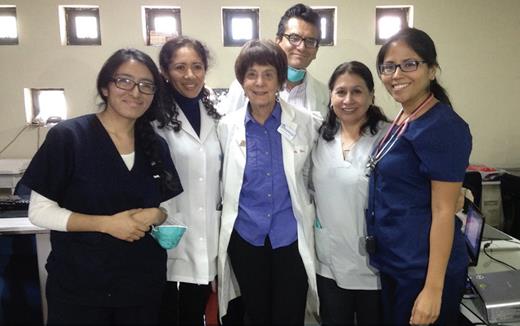Health Volunteers Overseas in Peru. L to R: Dr. Evelyn Marron (resident); Dr. Carmen Flores; Dr. Susan Harris (project director, HVO-ASH, Heme Peru); Dr. José Malaga; Dr. Mariela Fuentes (director of hematology, Escobedo/ Arequipa); Dr. Alejandra Vera (resident).
Health Volunteers Overseas in Peru. L to R: Dr. Evelyn Marron (resident); Dr. Carmen Flores; Dr. Susan Harris (project director, HVO-ASH, Heme Peru); Dr. José Malaga; Dr. Mariela Fuentes (director of hematology, Escobedo/ Arequipa); Dr. Alejandra Vera (resident).
ASH partners with Health Volunteers Overseas (HVO), a nonprofit organization dedicated to improving global health through education, to bring hematology consultation and training to hospitals in low-resource areas that care for hematology patients with a wide range of disorders. ASH member volunteers provide on-site training in the form of rounds in the clinics, bedside consultations, classroom lectures, training in the laboratories, and training in blood banking and transfusion medicine. The objective is sustainable improvement of hematology patient treatment at these institutions. Volunteer assignments generally range between two and four weeks.
Emeritus member Dr. Susan Harris serves as the project director for volunteer sites in Arequipa, Peru, at Carlos Alberto Sequin Escobedo Hospital and Catholic University of Santa Maria. Below is an interview with Dr. Harris, who visited local hematologists at these sites in June 2015 to determine areas where ASH volunteers could make the greatest impact through on-site training and consultation.
What is the status of hematology care in Arequipa, Peru, and what sort of disease burden are they dealing with?
Hematologists in Arequipa are very well trained and well read; they are very hard working and dedicated physicians. The majority of their inpatients have acute lymphocytic leukemia on both the pediatric and adult services, as well as lymphomas and aplastic anemia. They are the referral center for the southern part of Peru and have approximately 400 adult and 240 pediatric inpatients per year, as well as 8,000 adult and 4,000 pediatric outpatient visits per year, so they are very busy! They also have 25 ambulatory chemotherapy chairs (with oncology) that are filled daily.
What are the main issue areas that ASH volunteers can focus on to help improve hematology care in Arequipa?
This is almost the only postgraduate training available to the hematology staff and residents. In addition to ALL, they are interested in improving their interpretations of blood smears and bone marrows, as well as flow cytometry, blood banking, and hematopathology. Algorithms for the diagnosis and treatment of other areas of malignant and nonmalignant pathology are of interest as well.
How was your working relationship with the on-site hematologists and other staff during your visit?
The hematologists in Arequipa are enthusiastic about our program and make a concerted effort to make sure our volunteers have an impact on their staff as well as a gratifying experience. Dr. Mariela Fuentes, the director of hematology, has been particularly supportive and helpful. Some of the attendings and residents speak English quite well; the medical students are required to know English, and although they can read English, they have varied speaking abilities. A working knowledge of Spanish is helpful but not required. Fortunately, Dr. José Malaga, one of the senior hematologists, was a tour guide during medical school. His English is excellent, and he is especially helpful translating slides in conference! We have a new affiliation with Catholic University, one of the two medical schools there, and we hope some of our volunteers can participate in their programs as well.
Having served in Peru as an ASH volunteer and project director, what advice you would give an ASH member considering a volunteer assignment in Arequipa?
Although we prepare lectures in advance, we have to be flexible so that we can adjust to the local staff’s schedules and their clinical material. Although they have limited resources at times, we can try to help them achieve the best possible outcomes. In general, they do not have Macs available, so all presentations should be prepared in Word or converted to PDF.
Tell us a bit about your experience with Arequipa in general?
Arequipa is the second largest city in Peru, with approximately 1 million people living in the metropolitan area (Lima has approximately 10 million), at 7,600 feet above sea level, and surrounded by inactive volcanoes. It is a beautiful city, called Ciudad Blanca, because the buildings are made of sillar, a porous white volcanic stone, in Spanish colonial style. It was declared a UNESCO World Heritage site in 2000. The people are very friendly, with a mix of Indian and Catholic cultures. The food is tasty, and there are many well-priced restaurants. There are many interesting things to do for sight-seeing, including a city tour of Arequipa, Colca Canyon, Cusco, Machu Picchu, and, if one takes additional time, Lima and the Amazon.
Potential travelers should know that Peru is one of the few countries that has not been affected by the outbreak of Zika virus, and Arequipa is high and dry. However, prevention of mosquito bites is very important. I would strongly recommend spraying clothes with permethrin (available at a variety of department and sporting goods stores, as well as online), which lasts for two weeks or six washings, prior to packing, and using industrial DEET (>30%, e.g., ultrathion).

